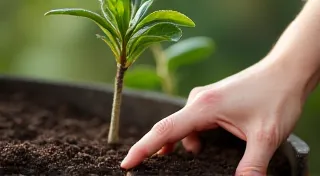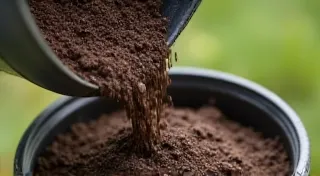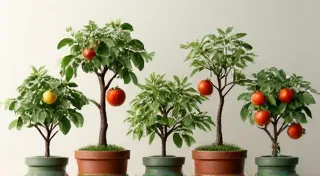Repotting Your Dwarf Fruit Trees in Containers: A Complete Guide
Growing dwarf fruit trees in containers is a wonderfully rewarding experience, especially for those with limited space. However, as your trees grow, their roots will eventually outgrow their pots. This is when repotting becomes essential for continued health and productivity. This guide will walk you through everything you need to know about repotting your dwarf fruit trees, ensuring they have the room to grow and thrive. Successfully cultivating these miniature marvels often involves more than just repotting; exploring the intricacies of selecting the right varieties is also key to maximizing your harvest. For those interested in expanding their collection, “The Joy of Miniature Fruit: Growing Rare Dwarf Varieties" offers a fascinating look at the world of unique and delicious dwarf fruit options.
Why Repotting is Crucial
Think of a pot as a home for your tree's roots. Just like any house, it can become too small. When roots become root-bound – circling the inside of the pot – they can restrict water and nutrient uptake. This leads to stunted growth, reduced fruit production, and a stressed tree. Repotting provides fresh soil, space for root expansion, and revitalizes the growing medium. The success of this process, however, is intrinsically linked to understanding the specific environmental needs of your chosen varieties. Optimizing the sunlight your trees receive is another vital aspect. Learning about Cartography of Sunlight: Mapping Microclimates for Container Fruit Bounty can help you ensure your trees are getting the perfect amount of light for optimal growth and fruiting.

When to Repot Your Dwarf Fruit Tree
Determining when to repot is key. Here are a few signs to look for:
- Roots Circling the Pot: This is the most obvious sign. Gently remove the tree from the pot and examine the root ball.
- Roots Emerging from Drainage Holes: Visible roots poking through the bottom of the pot indicate the tree is cramped.
- Slowed Growth: If your tree's growth has noticeably slowed, even with proper watering and fertilization, it might be root-bound.
- Frequent Watering Needed: A root-bound tree dries out much faster, requiring more frequent watering.
- Pot Deforms: The pot may show signs of bulging or deforming due to the pressure from the roots.
Generally, you should repot every 2-3 years for younger trees and every 3-5 years for more mature ones. Smaller fruiting trees may need repotting more frequently. Beyond the timing of repotting, creating a thriving ecosystem around your fruit trees is essential. Considering the right companions can make a world of difference – learn more about The Best Companion Plants for Dwarf Fruit Trees in Containers to boost your tree’s health and yield.
What You'll Need
- New Pot: Choose a pot that's 2-4 inches larger in diameter than the current pot. Ensure it has adequate drainage holes. Terracotta or plastic pots are both suitable.
- Potting Mix: Use a high-quality potting mix specifically formulated for fruit trees or container gardening. A mix of peat moss, perlite, and vermiculite is a good choice.
- Gardening Gloves: To protect your hands.
- Trowel or Small Shovel: For moving soil.
- Watering Can: To water the newly repotted tree.
- Pruning Shears (Optional): For trimming any circling roots.
Step-by-Step Repotting Guide
- Prepare the New Pot: Add a layer of potting mix to the bottom of the new pot, enough to raise the root ball to the desired height.
- Remove the Tree from the Old Pot: Gently tip the old pot on its side and tap the bottom to loosen the root ball. If the tree is stuck, you may need to use a trowel to carefully pry it out.
- Inspect the Root Ball: Carefully examine the roots. Gently loosen any circling roots with your fingers or use pruning shears to trim them. Don’t be afraid to trim – it encourages new, outward-growing roots. Remember that careful pruning is just one aspect of nurturing your fruit trees; proper fruit management is just as vital. Understanding the techniques involved in Fruit Thinning for Dwarf Fruit Trees in Containers: Why and How can dramatically improve the size and quality of your harvest.
- Position the Tree in the New Pot: Place the root ball in the new pot, ensuring the top of the root ball is about an inch below the rim of the pot.
- Fill in with Potting Mix: Fill the space around the root ball with fresh potting mix, gently firming it as you go.
- Water Thoroughly: Water the newly repotted tree thoroughly until water drains from the drainage holes.
- Post-Repotting Care: Place the tree in a sheltered location away from direct sunlight for a week or two to allow it to adjust. Continue regular watering and fertilizing as usual.

Important Considerations
- Repotting Time: The best time to repot is typically in early spring, just before the tree begins its active growth period.
- Don’t Overpot: Choosing a pot that's too large can lead to root rot, as the excess soil retains too much moisture. This is especially true for fruit trees that are not well-suited for container growing, and variety selection is key.
- Soil Amendments: Consider adding a slow-release fertilizer to the potting mix to provide nutrients for the tree. Organic matter like compost is also beneficial.
- Pruning: Light pruning after repotting can help encourage bushier growth and better air circulation, both vital for preventing disease.
Successfully navigating the complexities of container gardening often involves more than just technical knowledge; it demands a holistic understanding of the plant’s needs. For example, overwatering can be just as detrimental as underwatering. The type of potting mix you choose will play a significant role in moisture retention. Proper soil aeration, adequate drainage, and appropriate fertilization are all critical for maintaining your dwarf fruit trees’ vigor and resilience. Remember that the health of your trees is an investment that rewards you with bountiful harvests.

Repotting your dwarf fruit trees is a necessary part of their ongoing care. By following these steps, and expanding your knowledge of related gardening techniques, you can ensure your trees continue to grow and produce delicious fruit for years to come! Beyond just repotting, consider all aspects of your garden’s ecosystem and how they work together to support your miniature fruit trees’ ongoing success.





